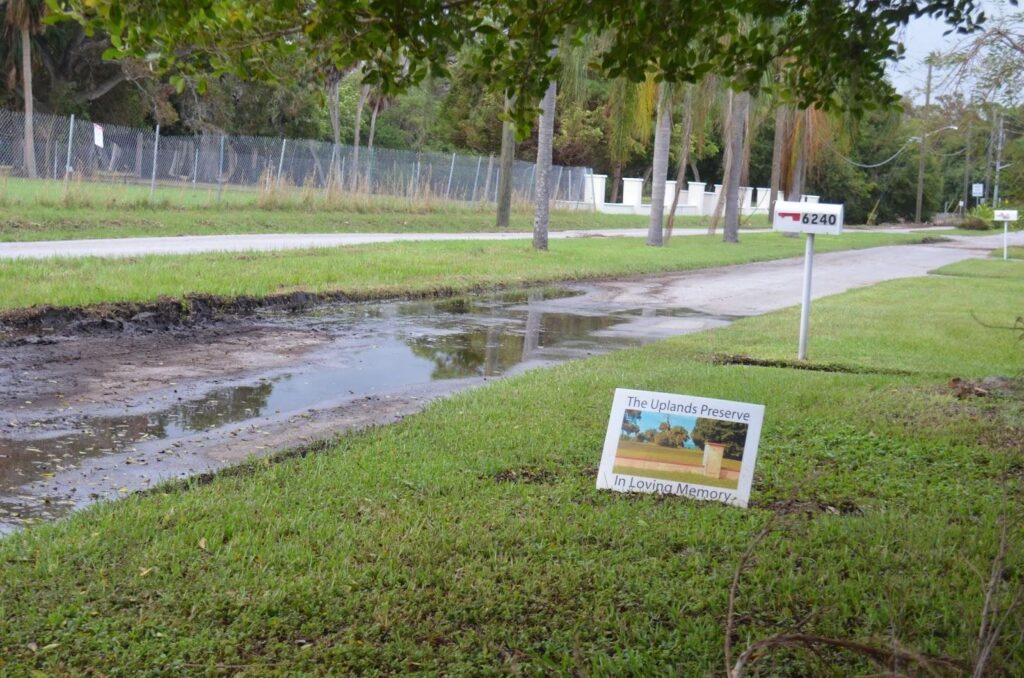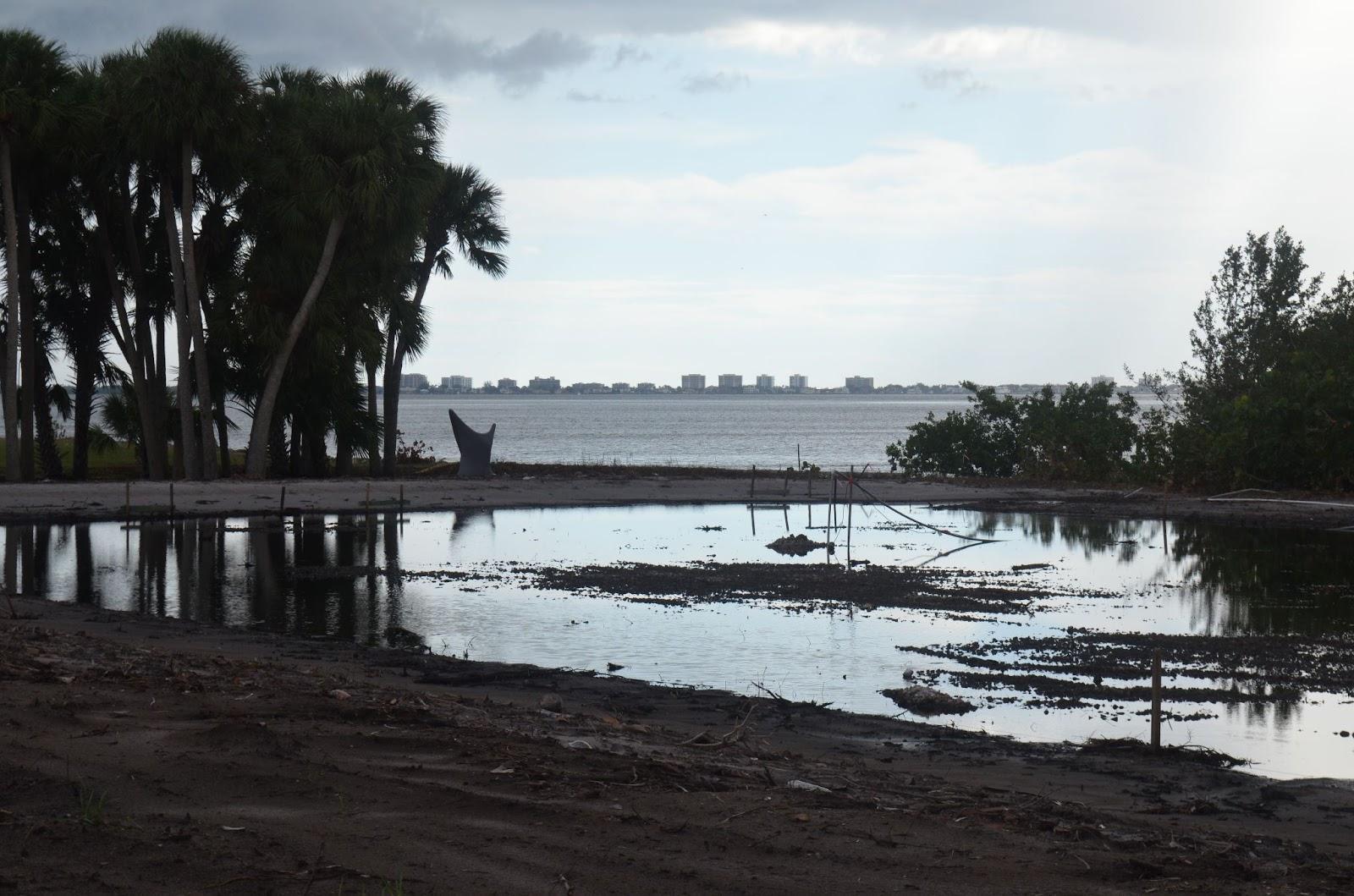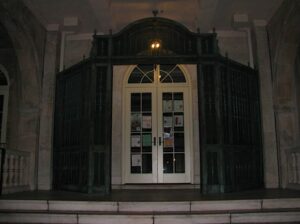Devil’s Chair and inundated volleyball field days after Hurricane Helene. Photo by Florence Fahringer.
The Uplands Preserve was slated to play a key role in the New College of Florida administration’s master plan for the campus. However, developments that followed have diverged from the 2024 plan. At every step of the way, residents of the neighborhood have reported feeling as bulldozed as the Preserve itself, as the administration’s unclear vision for the land has consistently heightened neighbors’ and nature’s misgivings.
In January 2024, the administration unveiled a new master plan that would see a “Freedom Institute” built on the Preserve. The institute, billed as a center for “promot[ing] tolerance of opposing views and a willingness to engage such views in civil discourse,” would take up half of the Preserve’s land, and would be bigger than any extant campus building. The other half of the land would be set aside for parking. Then, unannounced, construction crews began bulldozing the Preserve in May. At that point, New College President Richard Corcoran revealed new plans: the cleared land would host a new soccer field and volleyball court, while the old volleyball court on the other side of campus would be demolished to make way for ill-fated portable housing.

The Uplands preserve, wedged between the Uplands neighborhood and Sarasota Bay, had been given to New College upon its founding in the 1960s as a gift from an Uplands resident. With that transaction came an informal understanding that the land would remain undeveloped. Every New College administration has honored the agreement with the exception of current leadership. Residents of the Uplands neighborhood, who have used the land recreationally for decades, desperately but unsuccessfully tried to stop the destruction of what they considered their neighborhood park. Then, after the trees were cut and the dust had settled, they gathered in the rain and held a memorial service.
That service was held in front of Uplands resident Karen Stack’s house. Days later, Corcoran paid Stack’s home a visit, explaining his latest plans to a delegation of concerned neighbors. The good news was that he no longer planned to have the “Freedom Institute” built on the preserve. The bad news? He wanted to put dorms there instead.
As Stack recalled in a 2024 interview with Old School Catalyst, “[Corcoran] wants it for their students. As a reward of sorts for making it to their senior year, they get to be in housing on the bay. He made it sound like it would be a reward for four years well done at New College.” This change of plans came with no timeline and no specifics. When asked if there had been any overtures since the meeting, Stack answered, “No. He’s not talking to us. He had said he didn’t want to meet with us. If we had questions, we could text him; we can call him, that sort of thing. But he doesn’t want meetings.”

Beyond its function as a neighborhood park, Uplands residents valued the Preserve as a means of storm water management. The undeveloped, vegetated land acted as a buffer between the Sarasota Bay waters and the neighborhood, channeling rainfall back out to sea while the Preserve’s mangrove-lined shore kept the tides at bay.
Since the construction of the sports fields, three major weather events have rocked the Sarasota area. In mid-June, immediately after the Uplands’ vegetative barrier had been removed, a thousand-year rain event caused unprecedented flooding across the Suncoast. During construction, Uplands residents tried to get the attention of the Florida Department of Environmental Protection, as they were concerned with the use of chemical agents such as Roundup. The storm took place immediately following an unprecedented drought in the area, rendering the soil incapable of holding much water, exacerbating flooding and washing pesticides and pollutants out to sea. Executive Director of the Suncoast Waterkeepers Abbey Tyrna observed that in the wake of the storm, “There was really zero oxygen in the water from top to bottom” in the bay waters just off the Preserve, “and that is something that is pretty severe and would cause death to anything around.” A fish kill took place in Sarasota Bay in the weeks following the storm, with its epicenter off the coast of the Uplands Preserve.

Then, in September Hurricane Helene crawled its way past Sarasota’s shoreline. Stack said flooding was less severe than in June, noting that the storm surge was most serious in the part of the preserve where the sports fields had just been constructed. The volleyball field was inundated entirely, and a chain link fence that had been constructed to keep Uplands residents out had collapsed. When asked if Helene’s storm surge had impacted the administration’s plans for constructing fourth-year housing, Director of Communications Nathan March replied that “New College is revising its Master Plan. Community input has played a significant role. The public will continue to be consulted as the process continues.”
In October, Hurricane Milton made landfall. Where the June storm brought rain, and Helene brought sea, Milton brought wind. The category three hurricane knocked down trees across campus, including in the Uplands preserve. Stack notes that in the weeks following Milton, crews were sent out to not only clear debris, but also cut down seemingly healthy, unaffected trees: “They took down a lot more trees than they needed to. It felt like everything got rolled up in ‘Well, it’s Milton, this is the safer thing to do.’”
After this crescendo of natural disasters, residents came to the November 19, 2024 New College Board of Trustees meeting with concerns about even more development. One resident, Peter Schelhorn, was specifically concerned with the unspecified location of a “Home Depot-sized” building. Schelhorn asked the trustees, “How is it possible you’ve drilled down to this level of detail without even knowing where the building will be located?” Then he speculated aloud that it was “highly likely you know exactly where this structure will be located, and have chosen to withhold this information from the public […] Residents of the Uplands are very concerned you are once again intending to place this Home Depot-sized building on what remains of the Uplands Preserve.”
Corcoran’s response was inconsistent. At one point he stated that “on all of the master plan renderings, that building that they’re talking about is along Dort walkway and nothing’s changed. It’s still along Dort walkway, it will always be along Dort walkway.” Later he said that he can’t say exactly where the building will go, explaining “the reason we don’t say specifically where it’s going right now is because we don’t have an approved master plan, so I can’t.” He assured the trustees that “the controversy created about building some massive building, that’s their creation, and they want us to say no to it. I’ll say no to all of the creations of things that don’t exist […] If you can find someone who says I’ve broken my word, I’ll apologize, but I’m a man of my word.”

Stack said morale in the neighborhood was low at the end of 2024. “Honestly, as a neighborhood, there seems to be a sort of withdrawal of the passion of trying to slow down or stop or impact what Corcoran is doing. But he doesn’t listen, and I really don’t think he cares about us.
“I’m feeling a little overwhelmed by the amount of damage he’s done,” Stack continued. “It doesn’t feel like I’ve got even a small voice anymore. Before I thought, well we have a small voice, we can speak out […] But it doesn’t feel like we can move the needle even two degrees in any direction. We’re just ants in his way.” New College of Florida did not respond to additional requests for comment.
2025 has brought new opportunities for the New College administration. An annexation of both the Ringling Museum and USF-Manatee are now on the table. Should the latter come to pass, New College would gain control over the northernmost portion of the Preserve, and with it the entirety of the Uplands neighborhood’s access to Sarasota Bay. On top of that, a local funding initiative request submitted to the Florida Senate on Feb. 7 showed that the administration is continuing to ask for money to go towards a “Freedom Institute.” While none of the three million dollars requested would go towards construction, instead being used for salaries and live debates, the request still uses choice wording when describing the institute, saying that “it will serve as the new home for some existing programs, including the Socratic Stage and student debate initiatives.” Between these possible annexations, mixed messages from the New College administration, forecasts of another active hurricane season and the possibilities of a “Freedom Institute,” fourth-year housing or a “Home Depot-sized building,” the Uplands Preserve’s future remains in a precarious state of limbo. The only certainty is its past. A past of natural preservation in spite of a booming Sarasota. A past of a decades-long promise broken without warning. A past which illustrates that the greatest danger to one of the final bastions of undeveloped Sarasota bayfront is not the eyewall of a major hurricane, but the excavator and the bulldozer.




